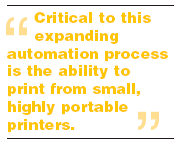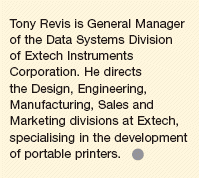 Most of us know that the increased efficiency and accuracy of capturing data quickly into a computing device can result in higher employee productivity, faster business reporting and reduced operational costs. We now have a new breed of workers who need to access data at their point of service or operation and who are increasingly being equipped for all-the-time data access, not merely data capture. Focus on the integration of mobility and technology merged with real-time information has resulted in an explosion of portable information devices and the increasing use of wireless technology.
Most of us know that the increased efficiency and accuracy of capturing data quickly into a computing device can result in higher employee productivity, faster business reporting and reduced operational costs. We now have a new breed of workers who need to access data at their point of service or operation and who are increasingly being equipped for all-the-time data access, not merely data capture. Focus on the integration of mobility and technology merged with real-time information has resulted in an explosion of portable information devices and the increasing use of wireless technology.
More companies are connecting their frontline workers so they are able to complete transactions at the point of sale or service. As such, applications for portable receipt printing are growing. Critical to this expanding automation process is the ability to print from small, highly portable printers that are durable enough, yet small and lightweight for easy use.
In retail, especially, there are many opportunities for wireless printing. Retailers can take advantage of wireless printing applications whether or not they have existing wireless networks. Whether the retailer uses a printer cable to connect between a handheld computer and printer or runs full applications with graphics downloaded from a high-speed wireless network, cost effective wireless printing technology is readily available.
Retailers know that reducing queue times at checkouts is a key factor in achieving customer satisfaction and enables retailers to offer their customers a superior service, especially during peak trading periods. Queue-busting solutions  enable retailers to set up mobile checkouts in-store, allowing customer lines to be dealt with on the spot drastically reducing customer waiting times. The system works by scanning products using a handheld device which accesses the retailers own system in real-time over a radio frequency (RF) infrastructure and thus provides up-to-date product, price and promotion information. Payment is taken by credit card and authorization obtained through the network. Receipts are then issued using lightweight mobile printers, worn by the staff.
enable retailers to set up mobile checkouts in-store, allowing customer lines to be dealt with on the spot drastically reducing customer waiting times. The system works by scanning products using a handheld device which accesses the retailers own system in real-time over a radio frequency (RF) infrastructure and thus provides up-to-date product, price and promotion information. Payment is taken by credit card and authorization obtained through the network. Receipts are then issued using lightweight mobile printers, worn by the staff.
The first breakthrough in wireless communication involved wireless personal area networking (WPAN)linking a handheld computer and printer, saymade use of Infrared communications. This culminated in the establishment of a universal standard, IrDA. IrDA is an effective low cost solution and, if implemented correctly, offers a robust interface with two-way communication up to one meter.
IrDA is likely to be the preferred wireless solution for simple short-range point-to-point transmissions, particularly with the current low cost.
Heralded as superior to IrDA, Bluetooth has just begun to make inroads in the handheld computing market. Bluetooth solutions are still relatively much more expensive than IrDA. However, there is the promise of a low cost of ownership, easeof-use and a fully interoperable system. The extra distance offered by Bluetooth is not so important in a personal area network scenario, but the promise of cost approaching that of IrDA and the absence of close line-of-sight makes the promise of Bluetooth intriguing WPAN, connecting hand-held computers with a range of peripheral equipment with either IrDA or Bluetooth, will dominate in mobile computing applications. Connectivity to wireless local area networks (WLAN) and wireless wide area networks (WWAN) will mainly be handled by radios in the computer system. The ability to seamlessly switch from a WLAN running 802.11b to peer-to-peer WPAN using Bluetooth will be a defining requirement for the future.

Opportunities for resellers
Resellers should be familiar with both IrDA and Bluetooth for WPAN use and be sure to understand the processes of implementing solutions using both methods. Applications defined for IrDA can also easily be covered by Bluetooth. Applications in addition to line busting include on-train and on-bus ticketing and field service receipts.
In data exchange with many devices available in close proximity, IrDA works extremely well. Resellers need to learn the fundamental differences created by the close, line of sight requirements of IrDA and the longer distance plus ability to communicate through solid objects inherent in the RF technology utilised in Bluetooth. An understanding of WLAN  technology is also important in retail and manufacturing and of WWAN technology for remote location data access.
technology is also important in retail and manufacturing and of WWAN technology for remote location data access.
The mobile computing market, of which wireless printing is an important part, opens up huge potential to the reseller channel, allowing resellers to improve their offerings to customers in terms of improved customer satisfaction and extremely quick return on investment after the implementation of wireless printing solutions. Also the elimination of cables is a major operational and cost benefit!

Add a Comment
No messages on this article yet